 |
|
 |
 |
|
 |
Choosing the right pool cue can be a difficult task, hopefully this will help a little bit.
Selecting a Cue Stick
It seems pool players are obsessed with the notion that, if they just had the right stick, they would shoot better. I certainly believe it, because I can not bring myself to accepting responsibility for my failure. I want to blame the cue stick every time I miss. So I search. I am looking for the perfect stick. I want a stick that knows what I want to do, and does it automatically. I want a stick that compensates for my stupidity and anxiety. I want a stick that I can take two of when I have a bad cold, or eat when I'm hungry. I want a stick I can have sex with; one that moans and tells me how good it was. I want a stick that lies to me.
I have shot with sticks that range in price from $10.00 to $1,000.00. I win and lose a lot of games, on big and small tables, in dingy bars and in high class billiard parlors. I am obsessed with the game, and I want to stay obsessed with it. I am not on the professional tour, because I am not good enough, and never will be, but not because of a stupid stick! Many of the tournaments were won with cheap, sticky house sticks. Once I am in stroke, I forget about the stick and focus on the balls. The balls don't seem to care, as long as I am in charge and not distracted. I do select a stick with good leather. Bad leather will distract me. A bad stick will not, once I have adjusted to it. (Within reason.)
I will stand by my conviction
that a stick is dead weight behind a piece of leather. There are, of course,
extenuating factors, chief among them being shaft flex. But that consideration
can be controlled, and even used by advanced shooters.
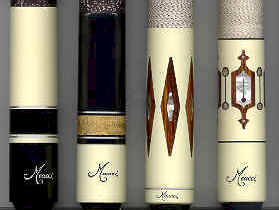 |
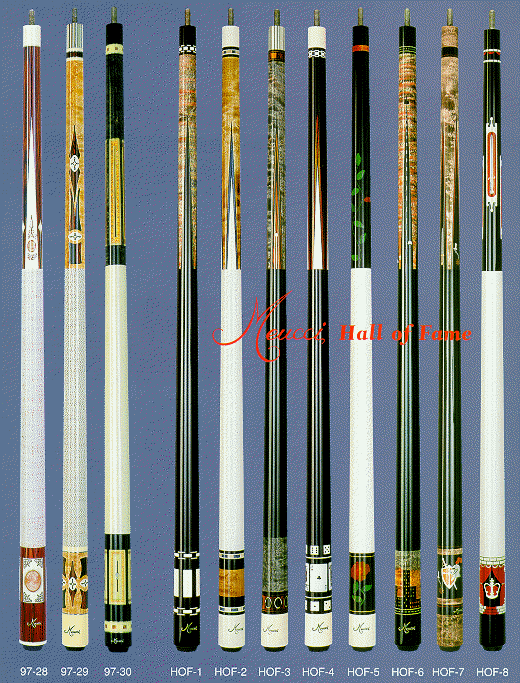 |
HIT
In my opinion, Robert Byrne
is the most knowledgeable instructor in the game today, and he knows how
to explain things in terms anyone can understand. I believe Robert Byrne
coined the term "squirt". I don't know where the term "hit" came from,
or even exactly what it means. I guess it refers to the instant that the
tip comes into contact with the cue ball. I don't like the term, because
it sounds violent, but I
can't think of a better term.
I hear and read a lot of debate regarding the stick's "hit". I have trouble with this. The player is responsible for the hit, not the stick. Even considering flex, weight, and other cue characteristics, the hit is controllable. Different controls may be required for different sticks, but it is the leather tip that contacts the cue ball, and where the leather meets the ball is controlled by the shooter. A flexible shaft may require a fuller hit to avoid squirt, for example. But one can not blame a stick with good leather for a bad hit. If the shooter puts too much spin on the ball, fails to chalk up, shoots too hard or soft, punches the shot, fails to follow through (ad infinitum) a bad hit can result. It isn't fair to compare the hit of two sticks, with different shaft characteristics or leather, by using the same contact point on the cue ball. Obviously the hit will be different. Every new stick requires that the shooter make adjustments. But changing sticks in the belief that the adjustments should not be necessary can get expensive, especially when our shooting techniques mature and evolve by nature. If you want a better hit, make adjustments, and hit it better. More shots are missed as the result of squirt than because of aim. Put a little less spin on the ball and watch your shot making percentage improve. Stop blaming the stick!
An experienced player can tell
by the stick's vibration whether or not the stick flexes too much. The
sound of the "hit" is important too, but the leather is mostly responsible
for the sound. I like to feel my hand on bare wood, so I will not shoot
with a glove. Although it is a minor consideration, I can feel the vibrations
of the stick better with a cue that does not have wrap on the butt. Unless
the player has enough shooting experience with a variety of sticks, sound
and vibration will not mean too much in stick selection.
 |
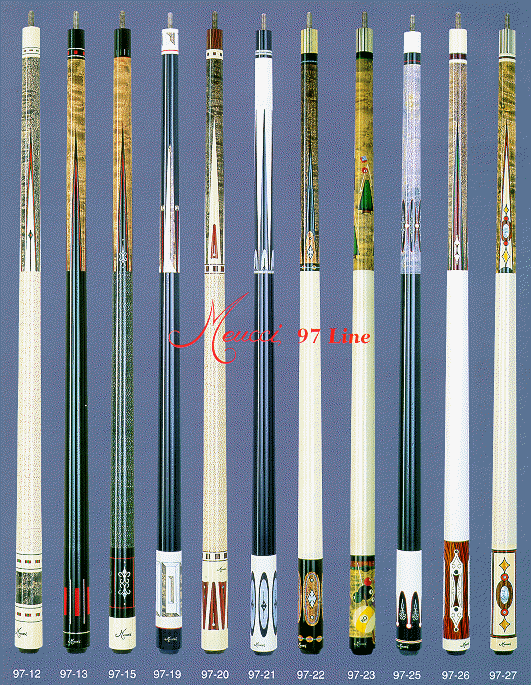 |
STICK SELECTION
The way a stick feels is important. All players want a stick that feels right in terms of weight, balance, shaft characteristics and leather. If it takes a few more bucks to find one that feels good, by all means make the investment. But if it takes thousands of dollars to find a stick that feels good, there is a serious problem. Yes, the finish on a stick is important. But, keep in mind that the same materials that go into an expensive custom cue can be found in moderately priced models. Rock Maple is Rock Maple. The grain is important, and the makers of higher priced sticks are usually more selective. But not necessarily. Cue makers are in business to make money; an honorable pursuit that often corrupts.
BEGINNER
Don't spend a lot of money on something you don't know how to use skillfully. Select an inexpensive stick, with the help of a more experienced friend. Examine the stick carefully for flaws, including finish, straightness, butt wrap and inlays. I would not suggest the purchase of a $19.00 K-Mart stick, although a pro player can kick butt with one. (I saw Jim Rempe beat some fine players, and he was using a mop handle.) Investments by beginners of over $175.00 is probably too much. Under $50 is probably too little.
INTERMEDIATE
Resist the urge to buy a $1,000.00 stick believing it will dramatically improve your game. If you want a better quality stick, consider something in the $300.00 range. Just make sure you really like the feel of it. Try some shots with heavy spin and feel the tell-tale vibrations. Do not upgrade to a stick that will require drastic changes in your stroke, unless you want to change your stroke.
ADVANCED
Get whatever damn thing you want. You deserve it.
CUSTOM CUES
I would love to start a collection
of expensive custom cues. Many are magnificent works of art. But, if I
could afford one I wouldn't use it for shooting. Works of art should be
displayed and preserved. You won't see many pro players using a $5,000.00
custom cue stick in competition.
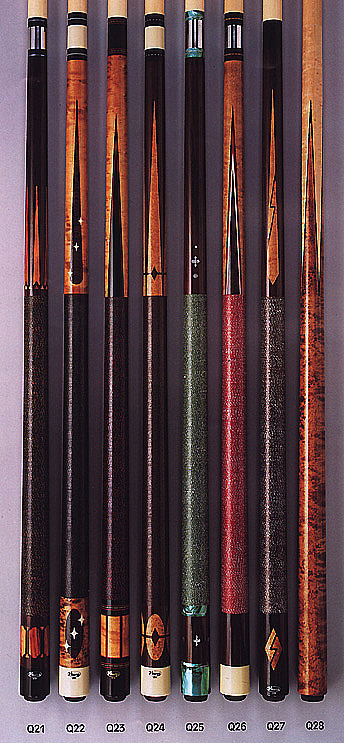 |
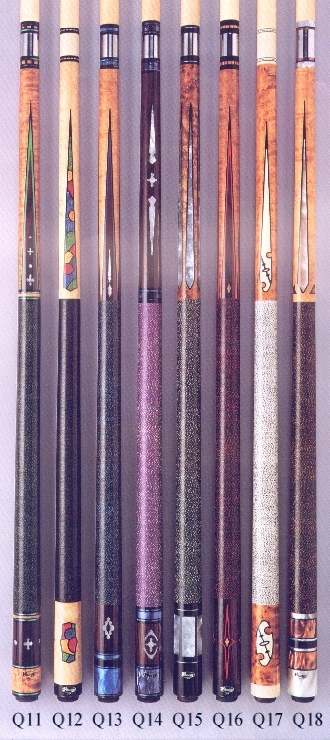 |
QUOTING GEORGE FELS
George Fels, in the April issue of Billiards Digest Magazine, covered the issue of cue stick shafts and tips: "Only the first 10 inches or so of a cue have any real effect on how the cue ball is struck, yet virtually all of the money we pay is for the other four feet."
Mr. Fels also pointed out that many high end custom cues are not made to be used: " ...we have recently witnessed an art show in Los Angeles in which cues were offered for sale at prices ranging up to a high living $55,000.00. Without having seen that wand, or knowing its creator or specs, I will venture that more concentration and effort have gone into its design than its tip. Yet, without appropriate regard for that weenie appendage - let's assume the worst and say it cost $25.00 - the other $54,975.00 spent for the rest of the cue would be utterly down the tubes, if the object d' art was indeed ever intended to hit a ball."
Right on Mr. Fels. But, I know you would love to own that $55,000.00 wand as much as I would. In truth, like everything else in life, we use what we can afford. If I owned a Rolls Royce, I would keep it under wraps, and probably under guard. There are those who routinely drive them to the grocery store.
If I could justify and afford
the cost, I would most definitely shoot with a $2,000.00 stick. I have
very strong convictions about the above cue stick issues, but I will always
want pretty new sticks that I hope will improve my game. They never have,
but serious practice and regular competition have done wonders.